Introduction
SEM (Search Engine Marketing) and display advertising are two popular forms of online advertising businesses use to promote their products or services. SEM involves placing ads at the top or right of search engine results pages, giving companies a competitive edge and increasing their visibility to potential customers. On the other hand, display advertising uses eye-catching visuals to capture audiences’ attention while browsing the internet, using social media, or using apps. These ads combine text, images, or videos and are displayed as sponsored content on relevant web pages. SEM and display advertising allow businesses to reach a wider audience, drive website traffic, and generate leads. While they have advantages and disadvantages, these advertising methods can effectively achieve marketing goals when used strategically and optimized.
What are SEM and Display Advertising?
A website is promoted using SEM, a digital marketing method, by improving its exposure in search engine results pages (SERPs) through paid advertising. It typically involves bidding on keywords relevant to the business and targeting specific demographics. When users search for those keywords, the ads appear at the top or bottom of the search results.
On the other hand, display advertising refers to the visual ads displayed on websites, mobile apps, or social media platforms. These ads come in various formats, such as banners, images, videos, or interactive content, and they can be targeted to specific audiences based on demographics, interests, or browsing behavior.
Why do Businesses use SEM and Display Advertising?
- Companies use SEM and display advertising for several reasons:
Display advertising and search engine marketing (SEM) make wider audience reach or increased visibility possible. Businesses can attract prospective clients by dominating the first page of search results or prominent websites.
- Advertising that is specifically targeted:
SEM and display advertising enable companies to target niche markets based on consumers’ interests, demographics, or online activity. Ensuring that the advertising is displayed to the most appropriate audience increases the likelihood of conversion.
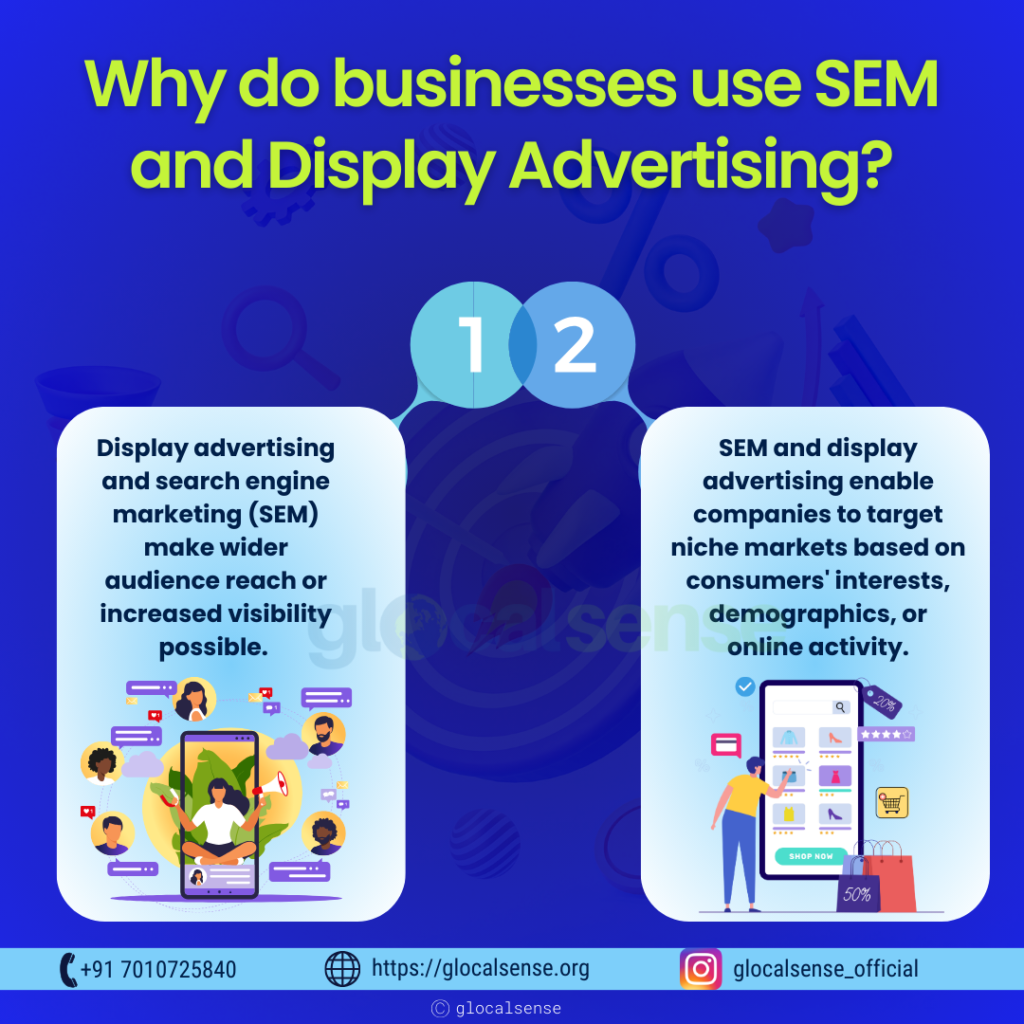
What is the Need for SEM and Display Advertising?
The need for SEM and display advertising arises from the increasing competition in the online marketplace. With millions of websites and businesses vying for attention, businesses must stand out and reach their target audience effectively. SEM and display advertising provide:
- The necessary tools to achieve these goals by increasing visibility.
- Targeting specific audiences.
- Driving traffic to websites.
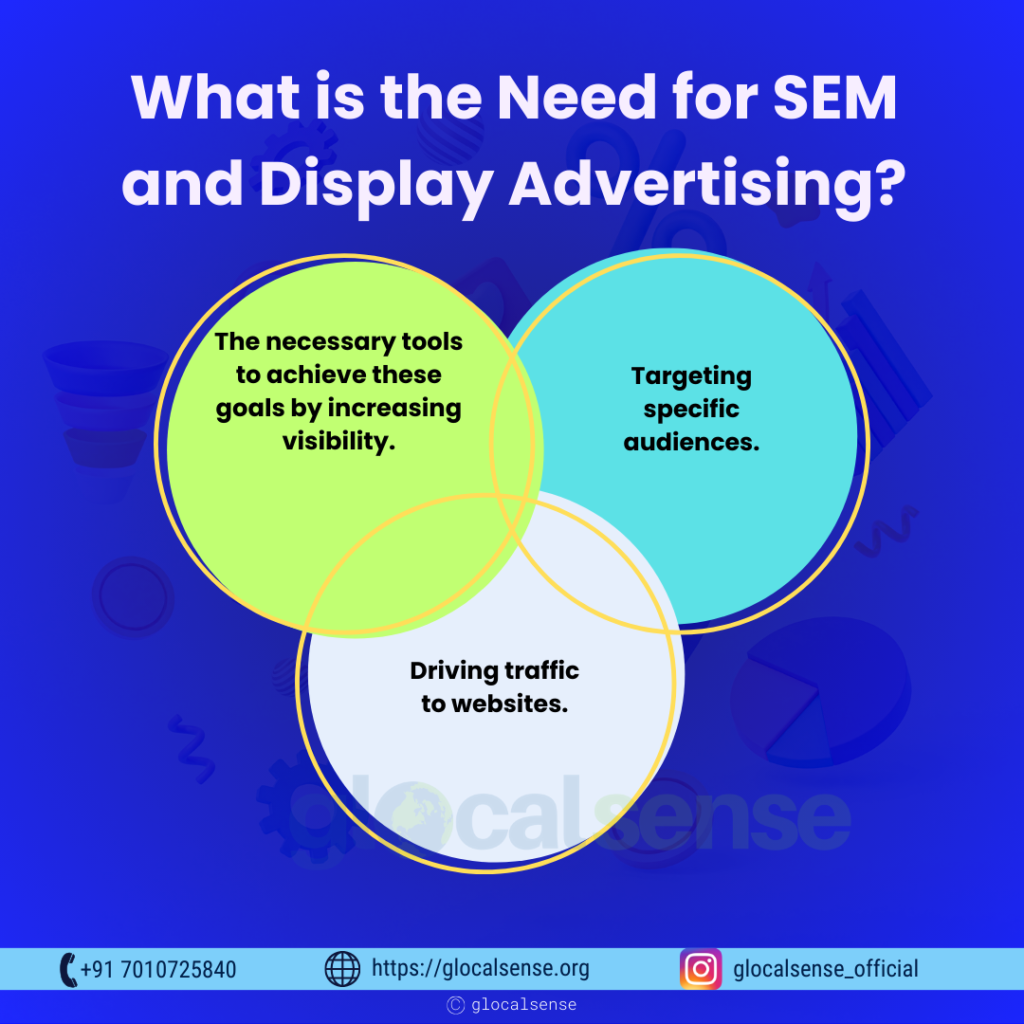
How do we use SEM and Display Advertising?
For an effective SEM, businesses must identify relevant keywords and create compelling ad copy encouraging users to click on the ads. They must also set up bidding strategies and allocate budgets to optimize their ad campaigns. Additionally, businesses can leverage tools like Google Ads to monitor and track the performance of their SEM campaigns.
For display advertising, businesses can use ad networks or platforms that allow them to create visually appealing ads. These platforms provide options for targeting specific audiences based on demographics, interests, or website placements. Businesses can optimize their display ad campaigns by selecting suitable targeting options and monitoring performance metrics.
Importance of SEM
SEM marketing strategies are essential for several reasons,
- Firstly, they contribute to digital marketing by targeting specific keywords that attract the most relevant audience for a product or service. SEM expands the reach of digital marketing and increases the chances of reaching potential customers.
- Secondly, SEM campaigns have high conversion rates as they position products or services in front of customers who are ready to purchase. SEM increases customer conversion rates and optimizes purchase intent, leading to higher sales.
- Thirdly, SEM strategies provide speed in driving increased traffic compared to SEO efforts, which can take longer to yield results. By placing ads at the top of search engine results pages (SERPs), SEM immediately exposes products and services to potential customers.
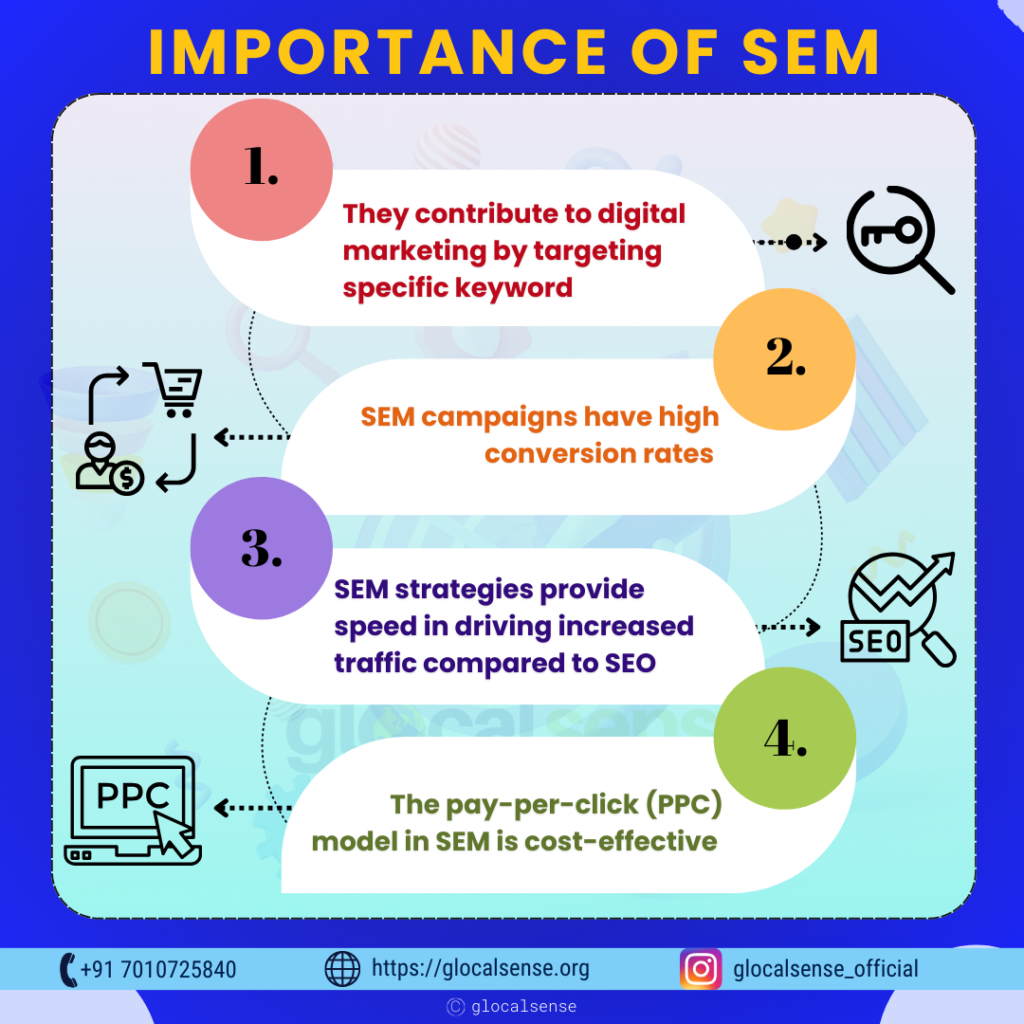
The pay-per-click (PPC) model in SEM is cost-effective, allowing organizations to pay only when their ads are clicked. This model provides control over ad spending with the ability to set maximum costs per click (CPC) and daily budgets.
SEM campaigns also contribute to increased organic rankings and trust signals. Successful SEM campaigns can lead to high organic rankings on SERPs, eliminating the need for ongoing SEM efforts.
Furthermore, SEM allows for segmentation based on geographic location, language, and online behavior, ensuring targeted reach to specific user groups.
Finally, tools like Google Analytics provide deep insights into the performance of SEM campaigns, enabling organizations to analyze and improve their strategies in real time.
In summary, SEM marketing strategies offer digital reach, high conversion rates, speed, cost control, organic ranking benefits, segmentation capabilities, and valuable insights for campaign optimization.
Five Key Takeaways for Display Ads
Developing a comprehensive full-funnel strategy that prioritizes creativity, targeting, offers, and user experience is crucial for long-term success. Display ads play a vital role in this strategy, effectively generating brand awareness, engagement, and advocacy. They are instrumental in communicating brand identity, culture, and differentiation. When implemented correctly, display ads offer significant scalability and efficiency. Key takeaways include:
- Recognizing the broad reach and versatility of display advertising across channels and funnel stages.
- Emphasizing proper targeting.
- Vital creativity and alignment throughout the customer journey.
- Adapting measurement approaches for display ad success.
- Leveraging responsive ad formats for faster testing and optimization.
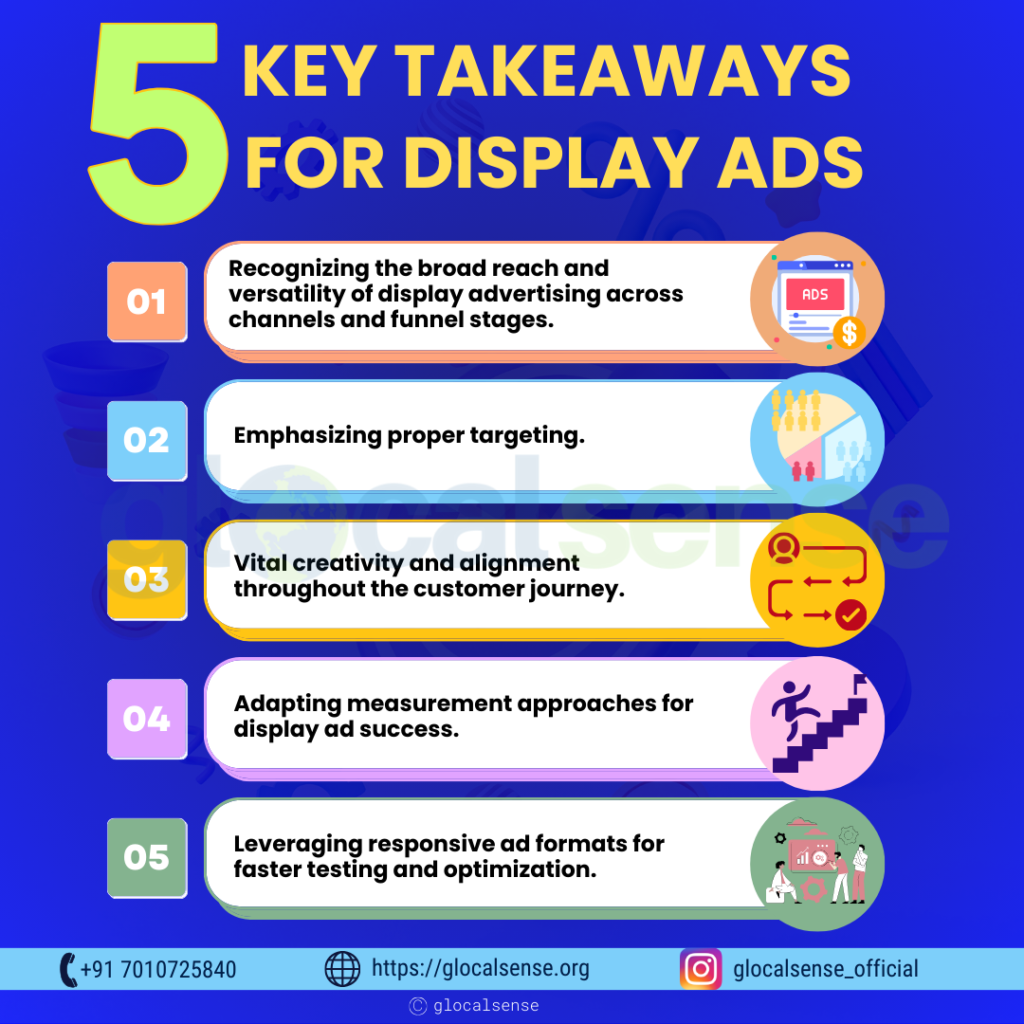
Six Benefits of Digital Display Advertising
Digital display advertising offers numerous benefits that can significantly impact your business. Here are six reasons why you should consider incorporating display advertising into your marketing strategy:
1. Outstanding Reach: Display advertising provides a vast reach, with platforms like the Google Display Network reaching many internet users. This extensive reach allows you to connect with a broad audience and maximize your brand exposure.
2. Excellent for Raising Brand Awareness: Display advertising is particularly effective in building brand awareness. While these ads may not directly target users ready to purchase, they are cost-effective and ideal for reaching and engaging your target audience and building brand recognition and familiarity.
3. Captivating Audience: Display ads leverage visually appealing graphics and designs to capture your audience’s attention. The engaging visuals help draw users’ focus to your brand, increasing the chances of creating a lasting impression and driving engagement.
4. The Abundance of Targeting Options: Display advertising offers various targeting options, enabling precise audience segmentation. Contextual targeting allows you to reach users based on their search engine activity and search history, while placement targeting empowers you to choose specific websites for ad placement. Demographic targeting helps you tailor ads to particular age groups, interests, and locations, while behavioral targeting serves ads based on users’ search and online behavior.
5. Various Pricing Options and Low Costs: Display advertising provides flexibility in payment options, including cost per impression (CPM) and cost per click (CPC). Both options offer cost-effective solutions compared to traditional advertising methods. CPC requires you to pay only when the users click on your ads, ensuring you get value for your ad spend.
6. Excellent Tracking Options: Display ads offer detailed tracking capabilities, allowing you to monitor the performance of your campaigns. You can measure impressions, clicks, and other engagement metrics, providing valuable insights to refine your strategy and optimize campaign performance in real-time.
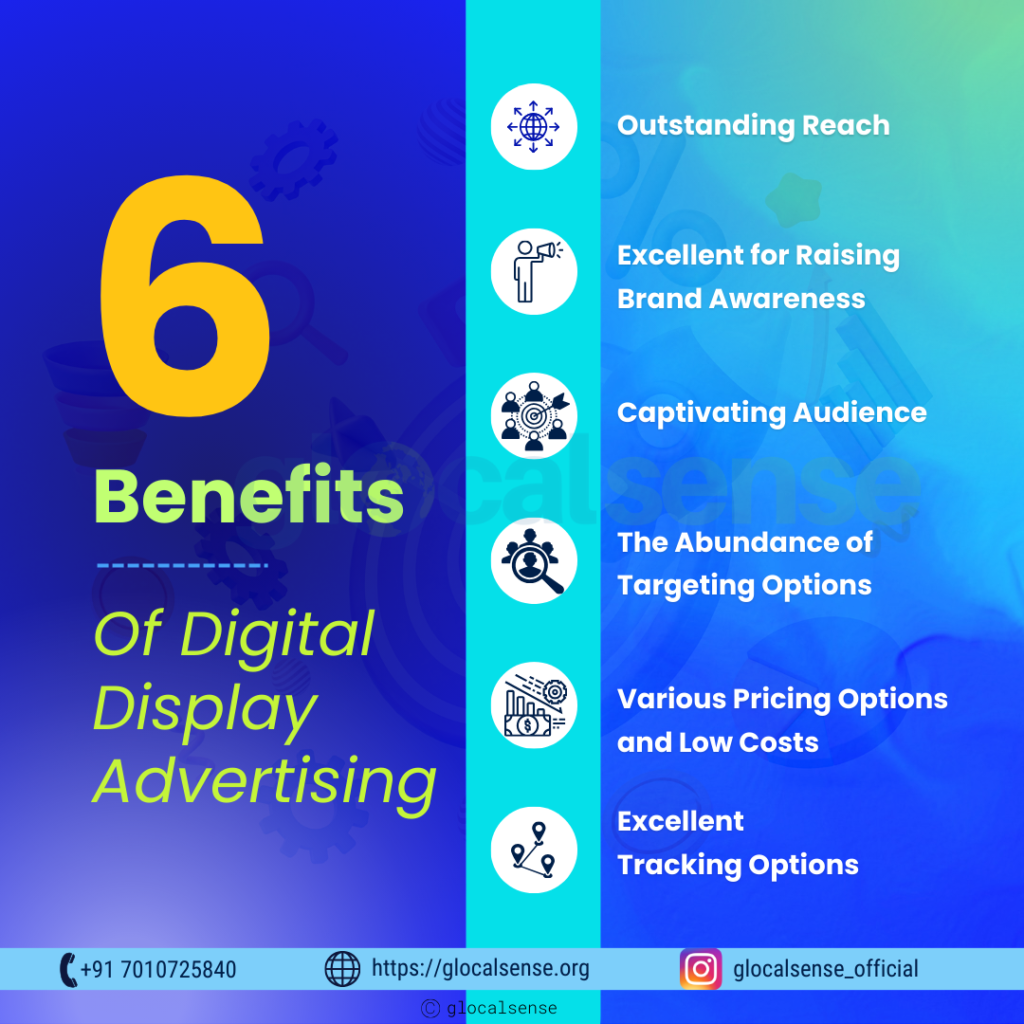
By leveraging the reach, brand awareness, captivating visuals, precise targeting, cost-effectiveness, and tracking capabilities of display advertising, you can enhance your marketing efforts and drive better results for your business.
Advantages and Disadvantages
Advantages of SEM (Search Engine Marketing) and Display Advertising
1. SEM and display advertising help firms reach a larger audience and boost their online exposure. With the help of search engine marketing, businesses may dominate the pages of search engine results, boosting their chances of drawing targeted traffic. With the help of display advertising, you may reach more potential customers by displaying your adverts across various websites, social media networks, and mobile apps.
2. SEM and display advertising provide sophisticated targeting capabilities that let companies reach particular demographics and focus on their ideal clientele. By selecting the keywords you want your ads to appear for using SEM, you can ensure that users actively looking for the items or services you’re advertising are seeing it.
3. Increase in possibilities of bringing in Targeted Traffic and Generating Leads: SEM and display advertising can bring in focused traffic to your website, boosting the potential for generating leads and conversions. Being found in search results for relevant terms to your business or displaying visually appealing adverts might draw people’s attention and persuade them to visit your website. Higher website traffic and more opportunity to turn visitors into customers may result.
4. The capacity to precisely gauge results is one of the key benefits of digital advertising. You can analyze the effectiveness of your campaigns by using the analytics and monitoring tools available through SEM and display advertising. You may monitor metrics like impressions, clicks, click-through rates, conversions, and return on investment (ROI), giving you information about your advertising campaigns’ success. With this data-driven strategy, you may make data-based decisions and adjust your campaigns for better results.
5. Flexibility in Budget Allocation and Ad Campaign Management: SEM and display advertising offer flexibility in budget allocation, allowing businesses to set their advertising budget based on their goals and financial resources. Additionally, you have control over various aspects of your ad campaigns, such as ad scheduling, ad copy, bidding strategies, and ad placements. This flexibility empowers businesses to adjust their campaigns as needed, optimizing performance and maximizing their advertising budget.
Disadvantages of SEM and Display Advertising
1. Costly: SEM and display advertising can be expensive, especially for competitive keywords or premium ad placements. Bidding on popular keywords in search engine marketing can drive up costs, making it challenging for small businesses with limited budgets to compete effectively. Similarly, display advertising on high-traffic websites or popular platforms may have a higher price tag.
2. Ad blockers and banner blindness pose challenges for display advertising. Ad blockers prevent ads from being displayed, reducing their visibility and reach. Moreover, users have become accustomed to ignoring banner ads, leading to lower engagement rates and effectiveness.
3. The digital advertising landscape is highly competitive, with numerous businesses vying for attention. Standing out among competitors can be challenging, especially in crowded industries or popular niches. It requires well-crafted ads, compelling messaging, and strategic targeting to overcome the competition and capture audience attention.
4. SEM and display advertising require ongoing monitoring and optimization to achieve maximum ROI. Ad campaigns need constant attention to analyze performance, identify areas for improvement, and make necessary adjustments. This continued effort demands time, resources, and expertise to ensure your campaigns remain effective and deliver the desired results.
5. Digital advertising is not immune to fraudulent activities like click fraud or invalid traffic. Click fraud involves intentionally clicking on ads to deplete an advertiser’s budget or artificially inflate ad metrics. Invalid traffic refers to non-human or low-quality traffic that doesn’t generate genuine engagement.
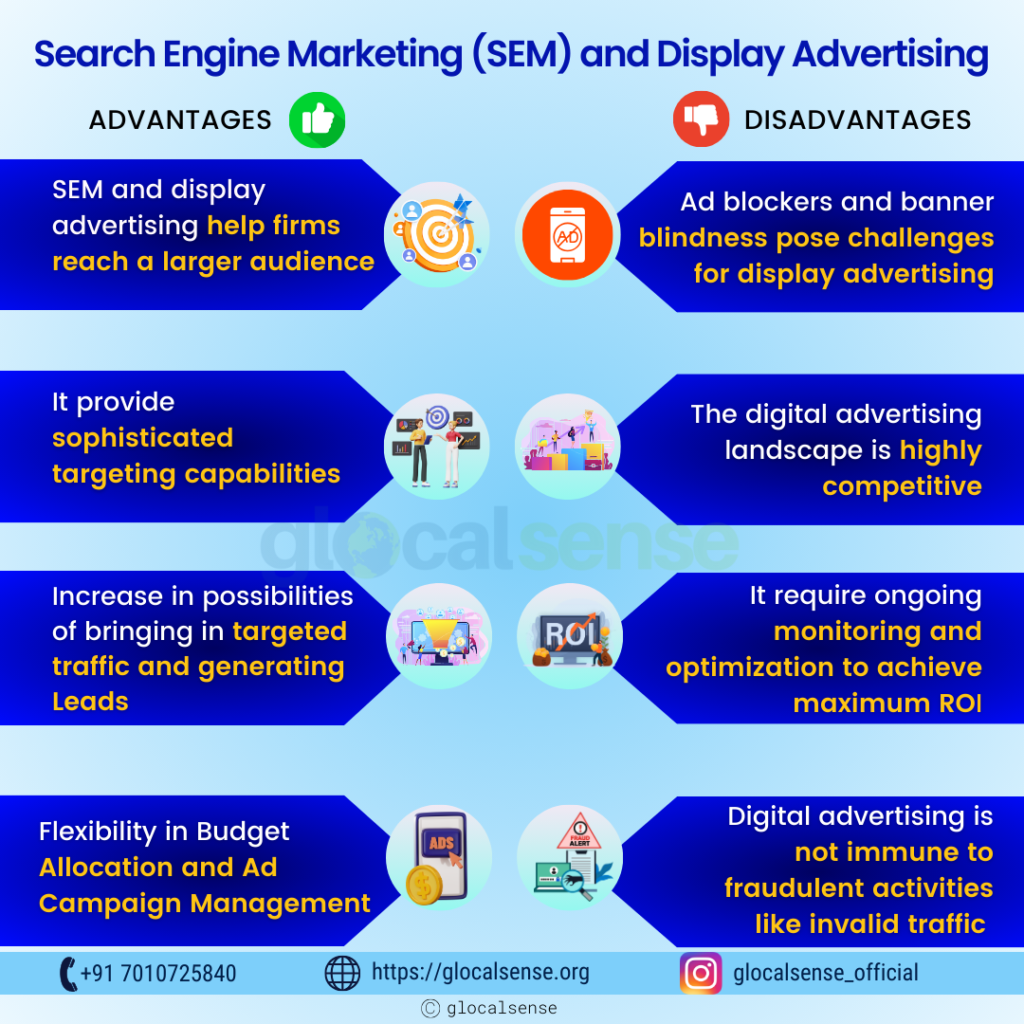
Conclusion
With the right approach and strategic planning, businesses can leverage the advantages of SEM and display advertising to maximize their online marketing efforts. By carefully selecting keywords and optimizing ad copy, SEM allows companies to position their ads in front of users actively searching for relevant products or services. This targeted approach increases the likelihood of driving qualified traffic to their websites and generating valuable leads.
Similarly, display advertising allows businesses to create visually appealing ads that can capture the attention of their target audience. By utilizing advanced targeting options, such as demographic and behavioral targeting, companies can ensure that their ads are shown to the most relevant users, increasing the chances of engagement and conversion.
However, it’s essential to be aware of the potential disadvantages and take steps to mitigate them. High competition and rising costs can pose challenges, but businesses can maximize their return on investment by conducting thorough keyword research, optimizing ad campaigns, and monitoring performance.
Additionally, addressing issues such as ad blockers and banner blindness requires creativity and adapting to changing consumer behaviors. Exploring alternative ad formats, such as native advertising or interactive content, can help overcome these challenges and capture users’ attention effectively.
Continuous monitoring, testing, and optimization ensure that SEM and display advertising campaigns remain effective. Businesses can refine their strategies by analyzing data, making data-backed decisions, and implementing adjustments to achieve better results over time.
In conclusion, SEM and display advertising offer significant advantages for businesses, including increased visibility, targeted advertising, and the potential for driving traffic and generating leads. By understanding the potential challenges and employing effective strategies to overcome them, businesses can harness the power of these advertising channels to grow their brand and achieve long-term success in the digital landscape.
